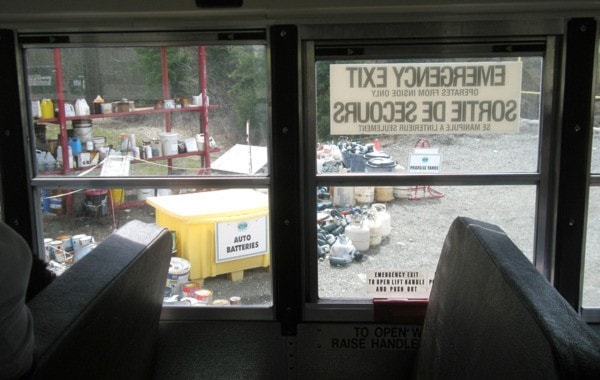Trash talk was the name of the game when Grade 7 students from Erickson Elementary School visited the Creston landfill.
The field trip was part of Wildsight’s Beyond Recycling, a program that educates students about waste, ecological footprint, climate change and energy use, and how to lessen their impacts. Developed in Fernie and offered in a number of Columbia Basin communities each year, Beyond Recycling is sponsored by the Regional District of Central Kootenay, Fortis BC, TD Friends of the Environment Fund, BC Hydro and Waste Management Inc.
While one would expect a typical landfill to be a dirty, smelly mess — 8,000 tons of garbage are dumped there each year — the students and Beyond Recycling facilitator Gillian Cooper were pleasantly surprised to find that the local landfill is tidy and relatively odour-free, blending well into its location.
“It’s known as the most scenic landfill in B.C.,” said Cooper. “When landfill inspectors come, they’re stunned by the view.”
“I thought it was really amazing how clean and organized the landfill was,” wrote Maia Bredt in a report following the tour.
The tour began at the bins where visitors dump garbage, which have a safety system that impressed at least one student.
“I thought they were very smart to have two railings by the bins, one for the people on the ground and one for the people in the back of trucks,” wrote Noelle Lavallee.
On the tour, conducted by Regional District of Central Kootenay resource recovery manager Mike Morrison, students saw areas that contain piles of scrap metal, hazardous soil and tires. Scrap wood taken to the landfill is chipped, any metal removed with a magnet, then spread as mulch over the main garbage pile at five-foot depths.
The garbage area was an eye-opener for the students, who were surprised by what they saw in the pile.
“There were broken toys, half of a sink, a dead fish, and a ripped purple and blue leather jacket,” wrote Jacob Poznikoff.
Since garbage in a landfill doesn’t rot quickly, the smelliest part was when the school bus drove past a spot containing a five-year-old mound of soybeans, recently uncovered by a new road.
“Suddenly, they all became aware the landfill smelled,” said Cooper. “The rest of it didn’t really smell.”
Mattresses and toys could also be seen in the landfill, as could food packaging, which led nicely into a discussion about local food, not to mention the pile of tires at the landfill — more local food would mean less transport trucks on the road and, therefore, less used tires, although what is there can be reused.
“The recycled rubber they use from tires or other things are usually put to a good cause like using rubber crumbs for under a playground facility,” wrote Jacob Dumas.
A greater effort to recycle topped the list of students’ plans following the tour.
“In a way the landfill helps us as humans because our waste can’t stay in our backyard,” wrote Megan Richardson. “Many people have to start cutting down their waste because it is affecting the environment and they dispose of 8,000 tons of garbage a year.”
The students were also impressed by the landfill employees’ efforts to keep the facility from having a negative impact on the area.
“Because if what I saw at the landfill, I’m going to try to reduce my garbage so that some of the best places in the world don’t get covered,” wrote Jennifer Bohn. “Even though I’m not exactly happy with the landfill and its size, I am impressed with how neat it is and how much the workers are trying to do for the environment.”
Cooper was impressed with how well the students expressed what they learned on the field trip.
“They came away on fire,” she said. “I didn’t think it was going to be so monumental, but it was.”
